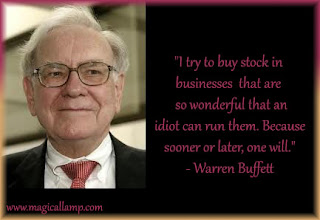I do a lot of case studies. I recommend that any burgeoning value investor do as many case studies as they can, sprinkled in among reading annual reports and other filings. I'll explain what I mean by this in a moment... first I thought the best investor/teacher of all time could explain the importance of this exercise better than me:
"To invest successfully, you need not understand beta, efficient markets, modern portfolio theory, option pricing or emerging markets. You may, in fact, be better off knowing nothing of these. That, of course, is not the prevailing view at most business schools, whose finance curriculum tends to be dominated by such subjects. In our view, though, investment students need only two well-taught courses - How to Value a Business, and How to Think About Market Prices."
Buffett has mentioned these "two courses" numerous times since this letter. He later mentioned that in the How to Value a Business course, he would simply "do one case study after another."
What Are Case Studies?
My short definition: A case study is reading about a specific investment result and then attempting to reverse engineer the thesis and the thought process that the investor had when he or she made the decision to buy the stock, and then taking note of how that thesis played out during the course of the investment.In other words, find a particularly good or bad investment result and ask, "Why?"
- What was the outcome? (note: you can learn from both good and bad results, but often times more from the ones that resulted in losses). This can be your own investments (the best case studies), or another investor's investments.
- Why did the investor decide to buy the stock?
- Why did the result turn out the way it did?
For starters, reading and studying Buffett's letters are probably the greatest things you can do to improve as an investor. I've read through them a few times, but I continue to review them and probably will do so throughout my career. I still learn something new each time. The great thing about reading Buffett's (and other fund managers') letters is that they often lay out their logic for us in a very clear and concise manner. They basically say "Here's why I did this, and here's why it worked (or didn't work)". So sometimes case studies are simply listening when other great investors are doing their own post-analysis.
Other times it's more complicated. I often read through old letters from various funds I follow and come across an investment that did extraordinarily well or extraordinarily poorly, but without further commentary. In this case, I might be inclined to dive deeper and read some old annual reports and try to really reverse engineer the investor's thought process.
All Knowledge Is Cumulative
Our investment decisions are partly based on the framework of our experience and each time I read Buffett's letters, I learn something or see something in a different way because over time my thought process and learning experience evolve. It's a latticework of various bits and pieces of experience and knowledge all coming together, and building on itself overtime.Buffett likens this learning process to compound interest. And as Pabrai says, "All knowledge is cumulative." So these case studies compound on themselves over time, improving our investment skill set and streamlining our ability to make decisions. Our filters get stronger, our risk management process becomes more robust.. As Buffett did, we get faster at saying no. It becomes easier to identify problems that might harm the investment, etc.

















